Gemological, Spectral and Chemical Features of Canary Yellow Chrysoberyl
Abstract
1. Introduction
2. Materials and Methods
3. Results
3.1. Gemological Results
3.2. Observation of Inclusions and Raman Results
Growth Lines
3.3. Fluids
3.4. Sillimanite Needles
3.5. Quartz and Muscovite
3.6. Raman Spectrum on the Chrysoberyl Host
3.7. FTIR Spectrum
- (1)
- In the 2000–2500 cm−1 range, two distinct peaks at 2405 and 2160 cm−1 are present in all samples, which can prove the samples as natural, differentiating them from the synthetic counterparts; as a matter of fact, such a pattern was absent in the synthetic chrysoberyl, as reported in the previous studies [22,23,24,25,26].
- (2)
- In the 2500–3000 cm−1 range, several weak shoulders are observed at 2762, 2840, and 2920, which could also be present in the synthetic material. Water and/or hydroxyl absorption bands in the 2500 to 3000 cm−1 range may come from the hydrous inclusions.
- (3)
- In the range between 3000 and 3500 cm−1, the 3223 peak is present in all samples, which can be accompanied by the 3112 shoulders of various strengths and the 3301 cm−1, along with the 3412 and 3432 cm−1 peaks.

3.8. UV-Vis and CIE Testing
3.9. The CIE Color Test
3.10. Luminescence and P.L.
3.11. Chemical Results
4. Discussion
4.1. LabCIE Analysis
4.2. Chemical Features and Color
4.3. Inclusions and Geological Implications
5. Conclusions
Author Contributions
Funding
Data Availability Statement
Acknowledgments
Conflicts of Interest
References
- Farrell, E.F.; Fang, J.H.; Newnham, R.E. Refinement of the chrysoberyl structure. Am. Mineral. 1963, 48, 804–810. [Google Scholar]
- Brown, W. The crystalline structure of chrysoberyl. Proc. R. Soc. Lond. 1926, 110, 34–63. [Google Scholar]
- Marder, J.M.; Mitchell, T.E. The Nature of Precipitates in Cat’s-Eye Chrysoberyl. Proc. Annu. Meet. Electron Microsc. Soc. Am. 1982, 40, 556–557. [Google Scholar] [CrossRef]
- Cronstedt, A.F. Försök til Mineralogie, Eller Mineral-Rikets Upställning [Attempt at Mineralogy, or an Arrangement of the Mineral Kingdom]; Kungliga Vetenskapsakademien: Stockholm, Sweden, 1758. [Google Scholar]
- Proctor, K. Chrysoberyl and Alexandrite from the Pegmatite Districts of Minas Gerais, Brazil. Gems Gemol. 1988, 24, 16–32. [Google Scholar] [CrossRef]
- Schmetzer, K. Russian Alexandrites; Schweizerbart Science Publishers: Stuttgart, Germany, 2010; 141p. [Google Scholar]
- Levine, G.B. Gemology: Alexandrite—It’s magic. Adornment 2008, 7, 7. [Google Scholar]
- Gubelin, E.J. Alexandrite from Lake Manyara, Tanzania. Gems Gemol. 1976, 15, 203–209. [Google Scholar]
- Zwaan, P.C. Sri Lanka: The gem island. Gems Gemol. 1982, 18, 62–71. [Google Scholar] [CrossRef]
- Brown, G.; Kelly, S.M.B. Alexandrite-chrysoberyl from Zimbabwe. Aust. Gemmol. 1984, 15, 275–278. [Google Scholar]
- Sun, Z.; Palke, A.C.; Muyal, J.; McMurtry, R. How to facet gem-quality chrysoberyl: Clues from the relationship between color and pleochroism, with spectroscopic analysis and colorimetric parameters. Am. Mineral. 2017, 102, 1747–1758. [Google Scholar] [CrossRef]
- Schmetzer, K.; Bernhardt, H.J.; Hainschwang, T. Measurement and interpretation of growth patterns in chrysoberyl, including alexandrite. J. Gemmol. 2011, 32, 129–144. [Google Scholar] [CrossRef]
- Schmetzer, K.; Krzemnicki, M.S.; Hainschwang, T.; Bernhardt, H.-J. Natural and synthetic vanadium-bearing chrysoberyl. J. Gemmol. 2013, 33, 223–238. [Google Scholar] [CrossRef]
- Schmetzer, K.; Caucia, F.; Gilg, H.A.; Coldham, T.S. Chrysoberyl Recovered with Sapphires in the New England Placer Deposits, New South Wales, Australia. Gems Gemol. 2016, 52, 18–36. [Google Scholar] [CrossRef]
- Lafuente, B.; Downs, R.T.; Yang, H.; Stone, N. The power of databases: The RRUFF project. In Highlights in Mineralogical Crystallography; Walter de Gruyter GmbH: Berlin, Germany, 2016; pp. 1–29. [Google Scholar] [CrossRef]
- McGuiness, C.; Wassell, A.M.; Lanigan, P.M.; Lynch, S.A. Separation of Natural Laboratory-Grown Diamond Using Time-Gated Luminescence Imaging. Gems Gemol. 2020, 56, 220–229. [Google Scholar] [CrossRef]
- Lanigan, P.M.; Mcguinness, C.; Rendle, M.; Aked, P.A.; Bearcroft, C.G.; Jones, D.C.; Lawson, S.C. Real-Time Detection of Long Lived Near Infrared luminescence from Colourless Cubic Zirconia by Time-Gated Imaging. Minerals 2020, 10, 891. [Google Scholar] [CrossRef]
- D’Haenens-Johansson, U.F.; Butler, J.E.; Katrusha, A. Synthesis of Diamonds and Their Identification. Rev. Mineral. Geochem. 2022, 88, 689–754. [Google Scholar]
- Hardman, M.F.; Eaton-Magaña, S.C.; Breeding, C.M.; Ardon, T.; D’Haenens-Johansson, U.F.S. Evaluating the Defects in CVD Diamonds: A Statistical Approach to Spectroscopy. Diam. Relat. Mater. 2022, 130, 109508. [Google Scholar] [CrossRef]
- Huang, T.; Gao, Y.; Sun, X.; Han, Q. Raman Spectroscopic Study on Inclusion in Sapphire from Azad-Kashmir. J. Gems Gemol. 2022, 24, 101–108. [Google Scholar] [CrossRef]
- Rybnikova, O.; Bačík, P.; Uher, P.; Fridrichová, J.; Lalinská-Voleková, B.; Kubernátová, M.; Hanus, R. Characterization of chrysoberyl and its gemmological varieties by Raman spectroscopy. J. Raman Spectrosc. 2023, 54, 857–870. [Google Scholar] [CrossRef]
- Leung, C.S.; Merigoux, H.; Poirot, J.P.; Zecchini, P. Sur Pidentification des pierres fines et de synthfese par spectroscopie infrarouge. Rewe Gemmol. 1983, 75, 14–15. [Google Scholar]
- Leung, C.S.; Merigoux, H.; Poirot, J.P.; Zecchini, P. Infrared spectrometry in gemmology. In Morphology and Phase Equilibria of Minerals, Proceedings of the 13th General Meeting of the International Mineralogical Association, Varna 1982, Sofia, Bulgaria, 19–25 September 1982; Bulgarian Academy of Sciences: Sofia, Bulgarian, 1986; pp. 441–448. [Google Scholar]
- Stockton, C.M.; Kane, R.E. The Distinction of Natural from Synthetic Alexandrite by Infrared Spectroscopy. Gems Gemol. 1988, 24, 44–46. [Google Scholar] [CrossRef]
- Schmetzer, K.; Peretti, A.; Medenbach, O.; Bernhardt, H.J. Russian Flux-Grown Synthetic Alexandrite. Gems Gemol. 1996, 32, 186–202. [Google Scholar] [CrossRef]
- Malsy, A.K.; Armbruster, T. Synthetic alexandrite—Growth methods and their analytical fingerprints. Eur. J. Mineral. 2012, 24, 153–162. [Google Scholar] [CrossRef]
- Witthayarat, J.; Thanasuthipitak, P. Crystal chemistry of coloration in chrysoberyl. In Proceedings of the 4th International Gem and Jewelry Conference, Chiang Mai, Thailand, 8–9 December 2014; pp. 185–187. [Google Scholar]
- Beurlen, H.; Thomas, R.; Melgarejo, J.C.; de Silva, J.M.R.; Rhede, D.; Soares, D.R.; Da Silva, M.R.R. Chrysoberyl-sillimanite association from the Roncadeira pegmatite, Borborema Province, Brazil: Implications for gemstone exploration. J. Geosci. 2013, 58, 79–90. [Google Scholar] [CrossRef][Green Version]
- Ma, Y.; Hong, T.; Liu, S.; Li, H.; Ma, H.; Wang, W.; Xu, X. Types and genetic mechanism of chrysoberyl deposits. Acta Petrol. Sin. 2022, 38, 943–962. [Google Scholar] [CrossRef]
- Thompson, R.N. Magmatism of the British Tertiary Volcanic Province. Scott. J. Geol. 1982, 18, 49–107. [Google Scholar] [CrossRef]
- Grew, E.S. Surinamite, taaffeite, and beryllium sapphirine from pegmatites in granulite-facies rocks of Casey bay, Enderby land, Antarctica. Am. Mineral. 1981, 66, 1022–1033. [Google Scholar]
- Franz, G.; Morteani, G. Be-Minerals: Synthesis, Stability, and Occurrence in Metamorphic Rocks. Rev. Mineral. Geochem. 2002, 50, 551–589. [Google Scholar] [CrossRef]
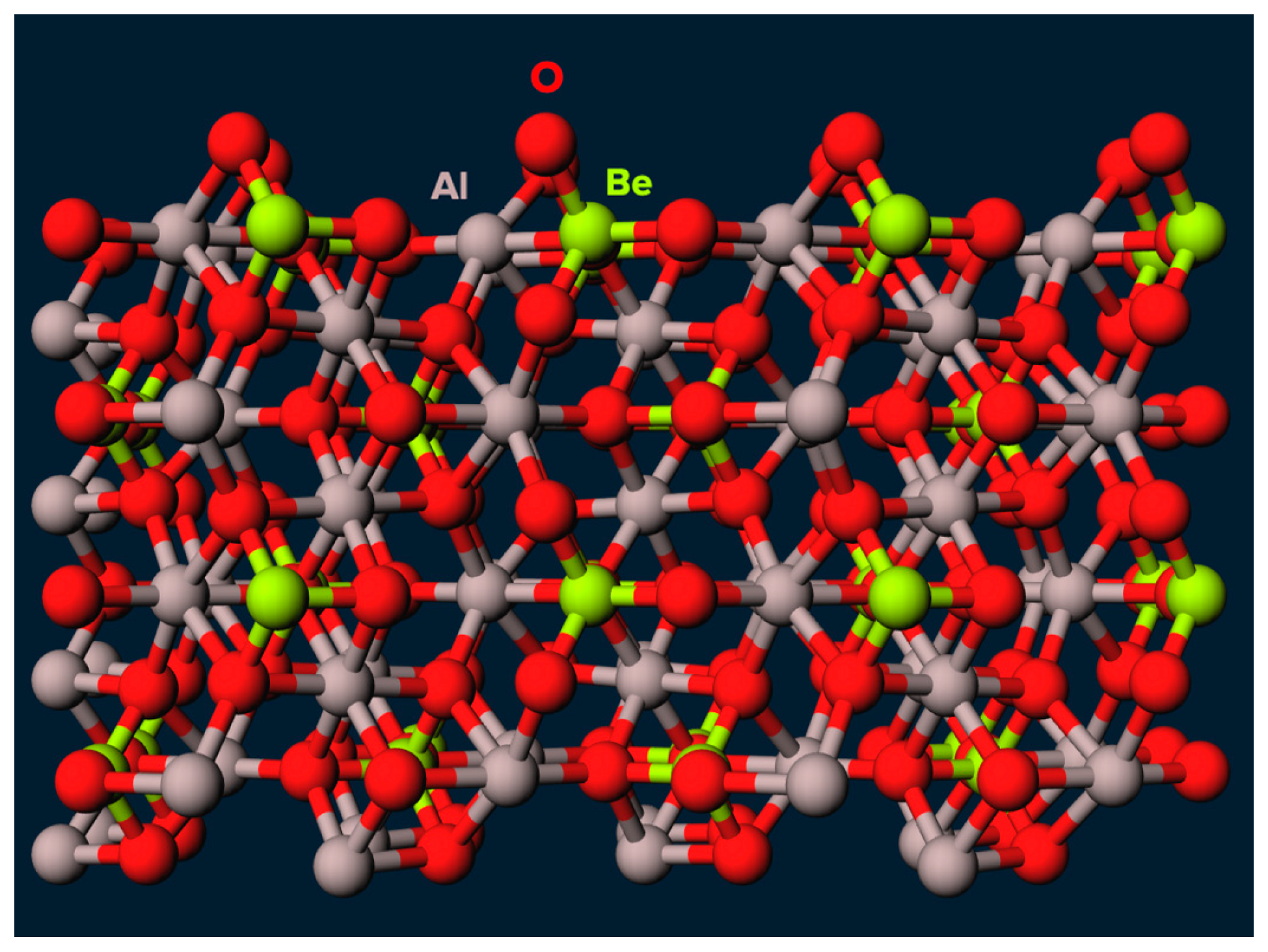
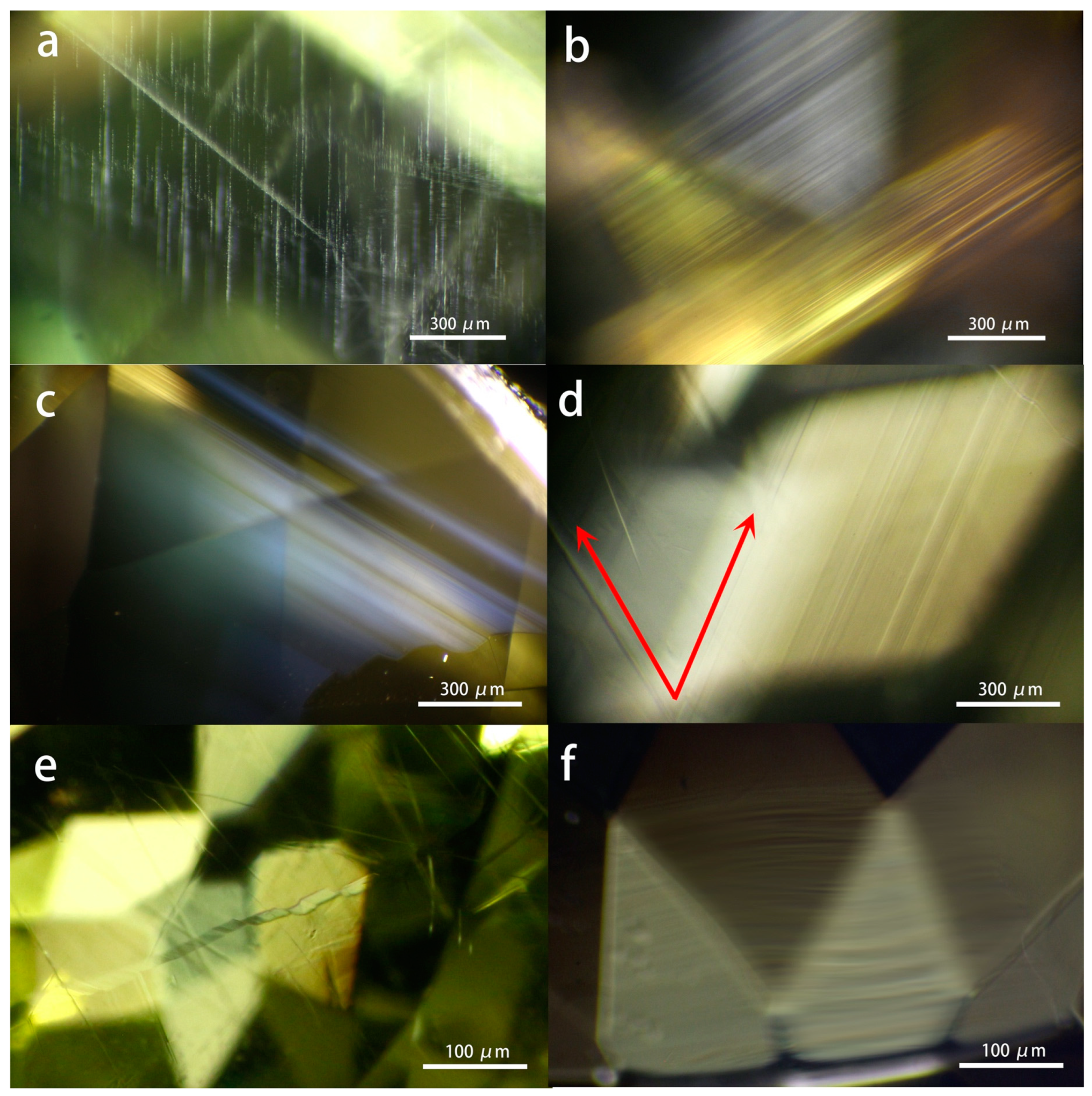
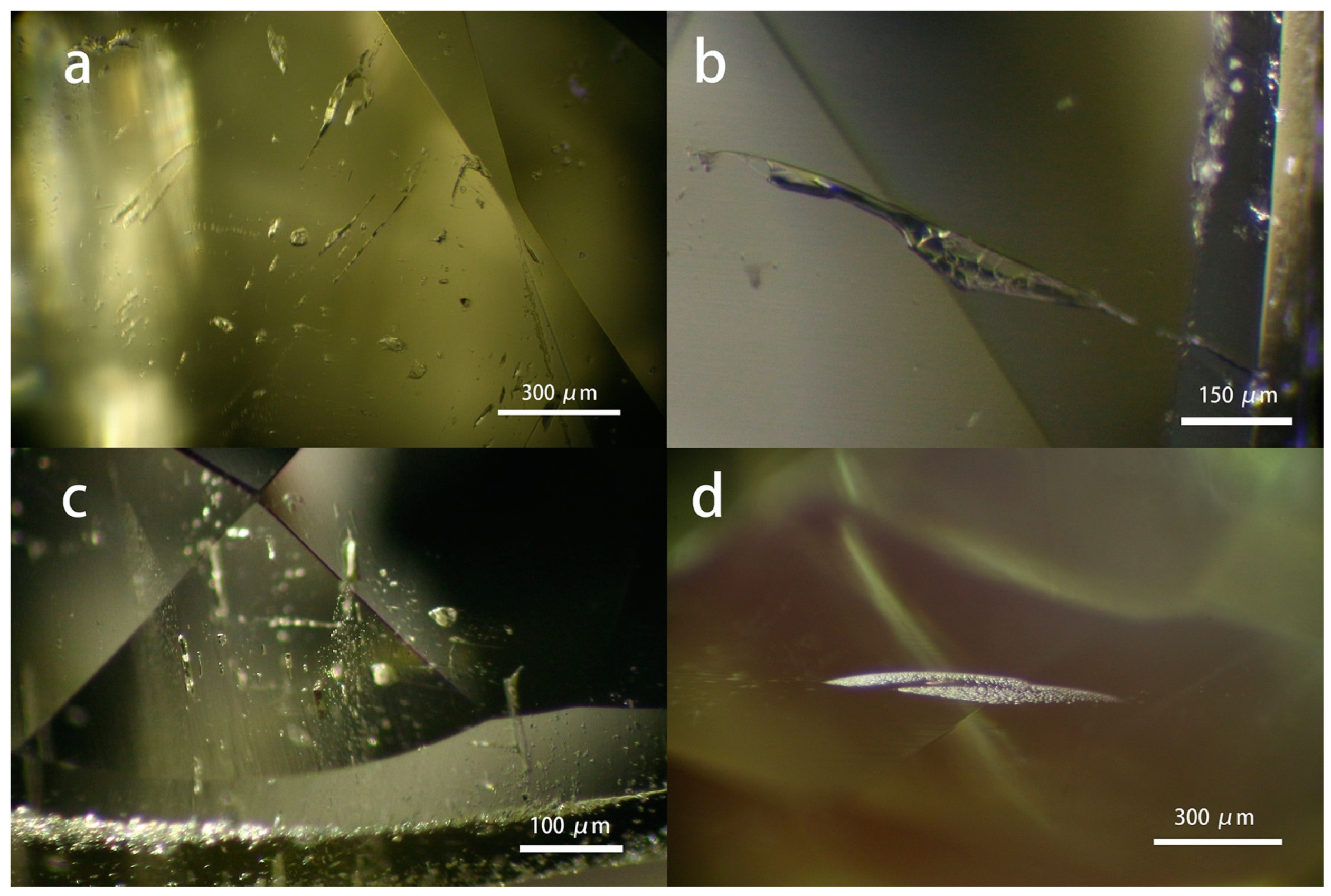




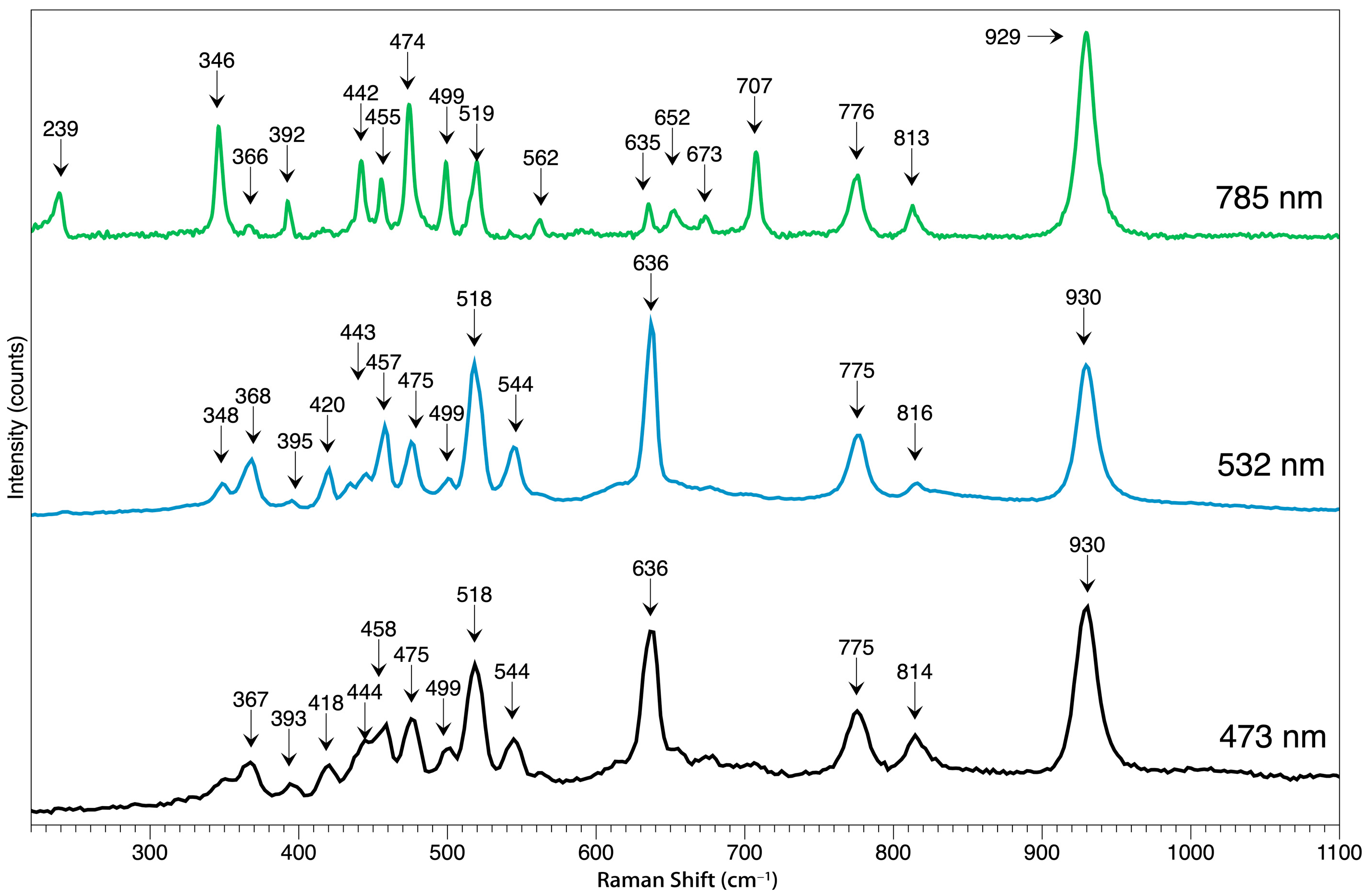
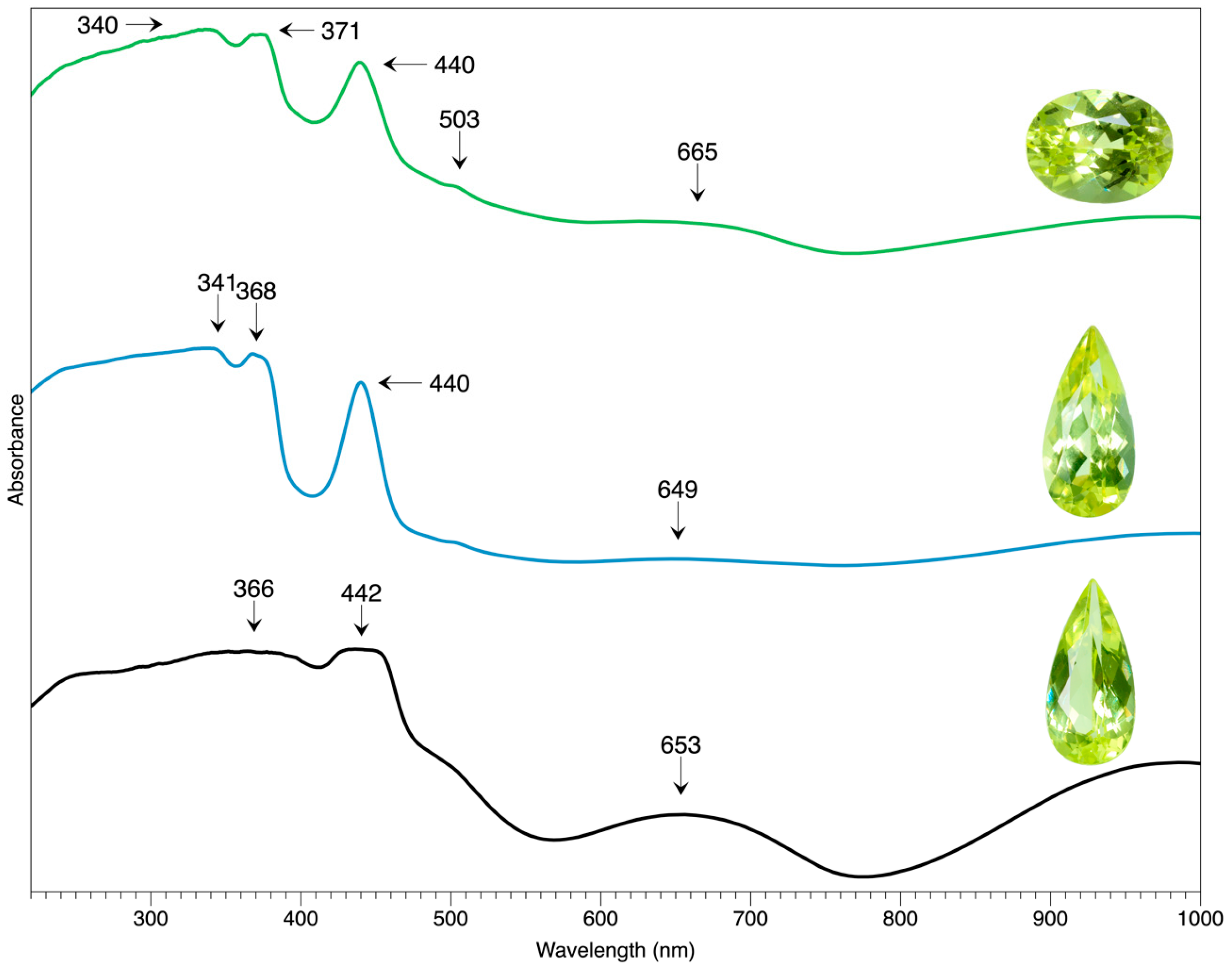
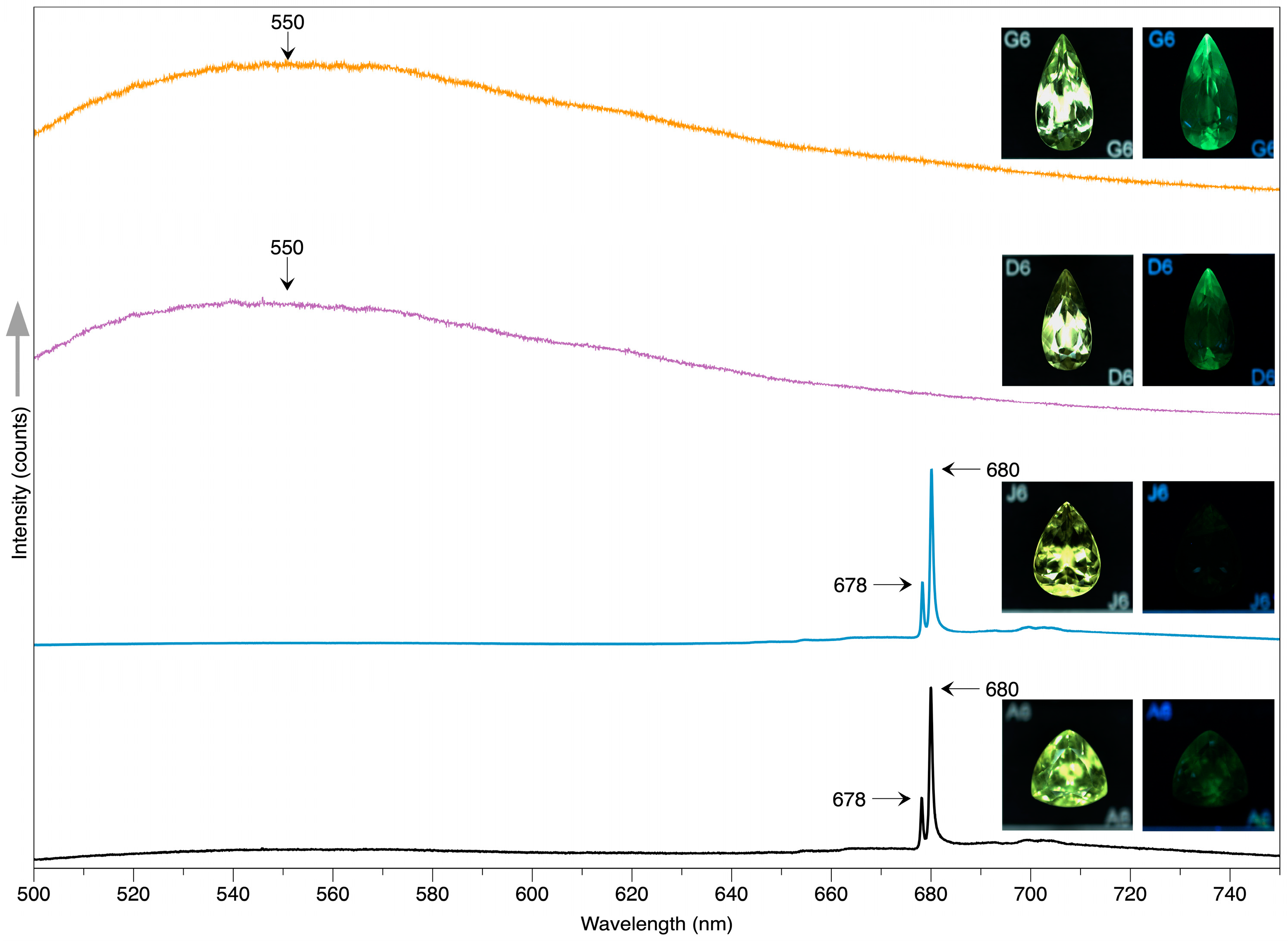

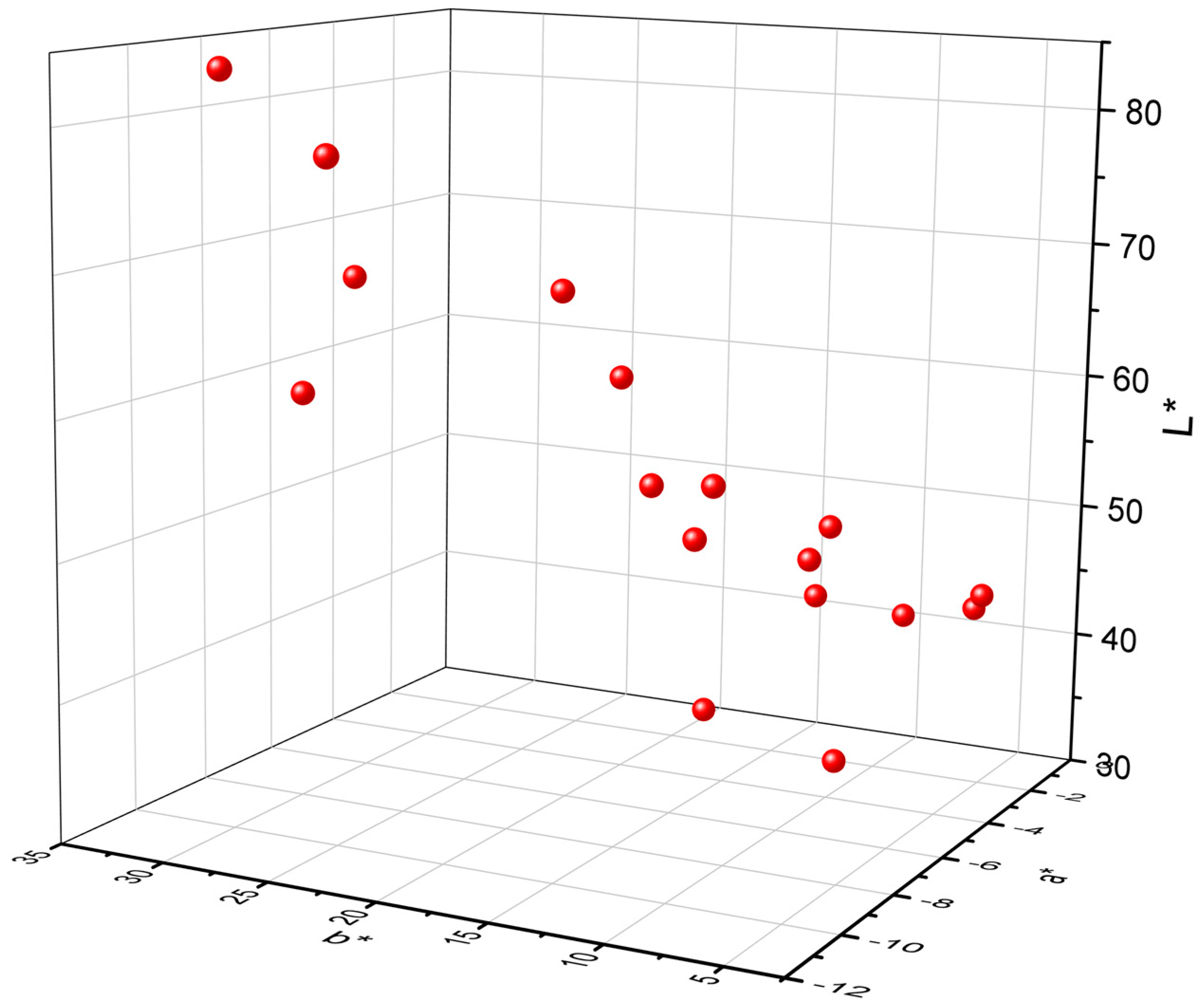
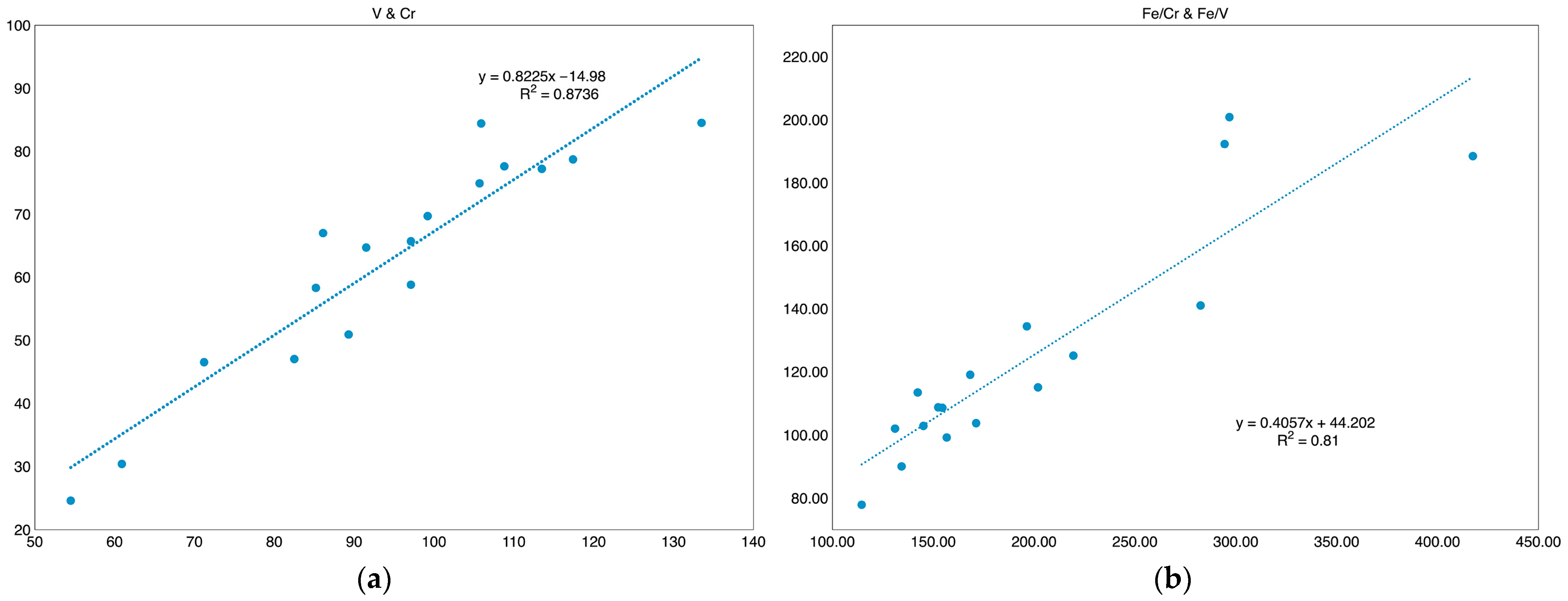
| No. | Weight | Shape | Dimensions | Sample Photo | No. | Weight | Shape | Dimensions | Sample Photo |
|---|---|---|---|---|---|---|---|---|---|
| G23001-1 | 4.05 ct | Triangular | 9.15 × 9.23 × 6.57 mm | 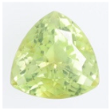 | G23001-10 | 3.46 ct | Pear | 11.28 × 7.93 × 5.80 mm |  |
| G23001-2 | 4.51 ct | Pear | 15.82 × 7.68 × 5.07 mm |  | G23001-11 | 2.79 ct | Pear | 10.74 × 7.71 × 5.12 mm |  |
| G23001-3 | 5.21 ct | Pear | 14.33 × 8.03 × 6.69 mm | 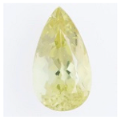 | G23001-12 | 7.43 ct | Pear | 14.01 × 9.45 × 8.09 mm |  |
| G23001-4 | 1.97 ct | Pear | 12.00 × 5.90 × 4.06 mm |  | G23001-13 | 2.09 ct | Oval | 8.96 × 6.91 × 4.65 mm |  |
| G23001-5 | 4.92 ct | Pear | 14.98 × 7.98 × 6.03 mm | 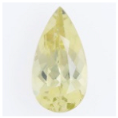 | G23001-14 | 2.12 ct | Oval | 8.94 × 6.95 × 4.73 mm | 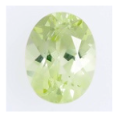 |
| G23001-6 | 2.10 ct | Pear | 11.96 × 6.00 × 4.45 mm | 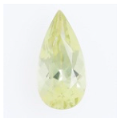 | G23001-15 | 6.00 ct | Oval | 10.75 × 9.84 × 7.48 mm | 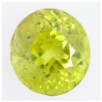 |
| G23001-7 | 2.87 ct | Pear | 13.76 × 6.82 × 4.33 mm | 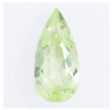 | G23001-16 | 4.16 ct | Oval | 10.68 × 8.46 × 6.34 mm |  |
| G23001-8 | 3.05 ct | Pear | 13.72 × 6.80 × 4.83 mm | 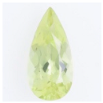 | G23001-17 | 3.09 ct | Cushion | 9.83 × 7.76 × 4.98 mm |  |
| G23001-9 | 4.81 ct | Pear | 15.01 × 8.00 × 5.97 mm |  |
| Weight | 1.97 ct to 7.43 ct |
|---|---|
| Color | Yellow is the primary hue, accompanied by a tint of greenish secondary hue, with low to medium saturation |
| Clarity | Medium to high clarity |
| Refractive index | 1.743–1.751, birefringence: 0.008 |
| Optical character | Biaxial positive |
| Fluorescence | Inert under 365 nm, exhibiting green fluorescence of various strengths under the 220 nm |
| Internal features | 1. Fluids 2. Straight growth lines 3. Minerals inclusions, muscovite, sillimanite, and quartz 4. Carbon-related substances, CO2, carbon, and calcite |
| Chemical features | Rich in Fe, a trace of V and Cr, Sn of various levels |
| No. | L* | a* | b* | c* | h* |
|---|---|---|---|---|---|
| G23001-1 | 50.25 | −5.80 | 14.30 | 15.43 | 112.07 |
| G23001-2 | 32.48 | −3.74 | 9.95 | 10.63 | 110.59 |
| G23001-3 | 43.00 | −2.23 | 12.73 | 12.93 | 99.95 |
| G23001-4 | 49.10 | −2.82 | 11.46 | 11.80 | 103.82 |
| G23001-5 | 43.38 | −1.14 | 5.94 | 6.05 | 100.84 |
| G23001-6 | 47.63 | −3.89 | 11.21 | 11.86 | 109.12 |
| G23001-7 | 54.79 | −6.28 | 12.90 | 14.35 | 115.94 |
| G23001-8 | 54.41 | −6.36 | 15.64 | 16.89 | 112.14 |
| G23001-9 | 41.43 | −1.46 | 9.32 | 9.44 | 98.87 |
| G23001-10 | 42.06 | −0.93 | 6.49 | 6.56 | 98.19 |
| G23001-11 | 67.86 | −6.52 | 19.73 | 20.78 | 108.28 |
| G23001-12 | 34.84 | −3.68 | 16.32 | 16.73 | 102.70 |
| G23001-13 | 83.59 | −9.78 | 30.97 | 32.48 | 107.52 |
| G23001-14 | 78.47 | −10.36 | 24.97 | 27.04 | 112.53 |
| G23001-15 | 59.74 | −7.82 | 30.29 | 31.28 | 104.48 |
| G23001-16 | 67.40 | −6.39 | 30.03 | 30.70 | 102.02 |
| G23001-17 | 60.57 | −4.83 | 19.15 | 19.75 | 104.16 |
| Average | 53.59 | −4.94 | 16.55 | 17.33 | 106.07 |
| Standard Deviation | 14.50 | 2.84 | 8.15 | 8.51 | 5.40 |
| No. | Ti | V | Cr | Mn | Fe | Ga | Sn | Fe/Cr | Fe/V | Fe/(V + Cr) | V/Cr |
|---|---|---|---|---|---|---|---|---|---|---|---|
| G23001-1 | 744 | 133.5 | 84.5 | 24.7 | 13,240 | 2070 | 814 | 156.69 | 99.18 | 60.73 | 1.58 |
| G23001-2 | 121 | 86.1 | 67 | 24.3 | 8781 | 2093 | 781.5 | 131.06 | 101.99 | 57.35 | 1.29 |
| G23001-3 | 177.5 | 113.5 | 77.2 | 26.1 | 8841 | 2689 | 51 | 114.52 | 77.89 | 46.36 | 1.47 |
| G23001-4 | 245.4 | 82.5 | 47 | 30.4 | 9490 | 2625 | 55.6 | 201.91 | 115.03 | 73.28 | 1.76 |
| G23001-5 | 221 | 60.9 | 30.4 | 28 | 8588 | 1989 | 83.3 | 282.50 | 141.02 | 94.06 | 2.00 |
| G23001-6 | 220.7 | 54.5 | 24.6 | 26.7 | 10,270 | 1908 | 145 | 417.48 | 188.44 | 129.84 | 2.22 |
| G23001-7 | 543.9 | 97.1 | 58.8 | bdl 1 | 10,070 | 1956 | 560.4 | 171.26 | 103.71 | 64.59 | 1.65 |
| G23001-8 | 216.2 | 89.3 | 50.9 | bdl 1 | 11,170 | 2975 | 3461 | 219.45 | 125.08 | 79.67 | 1.75 |
| G23001-9 | 266.9 | 105.7 | 74.9 | 27.9 | 10,870 | 3115 | 563.3 | 145.13 | 102.84 | 60.19 | 1.41 |
| G23001-10 | 113.9 | 105.9 | 84.4 | 25.1 | 12,010 | 3703 | 519.8 | 142.30 | 113.41 | 63.11 | 1.25 |
| G23001-11 | 310.3 | 99.2 | 69.7 | bdl 1 | 10,770 | 1722 | 130 | 154.52 | 108.57 | 63.77 | 1.42 |
| G23001-12 | 227 | 85.2 | 58.3 | bdl 1 | 11,450 | 1379 | 1260 | 196.40 | 134.39 | 79.79 | 1.46 |
| G23001-13 | 58.6 | 91.5 | 64.7 | 24.1 | 10,890 | 3272 | 175.5 | 168.32 | 119.02 | 69.72 | 1.41 |
| G23001-14 | 108.6 | 117.4 | 78.7 | bdl 1 | 10,570 | 2880 | 309.7 | 134.31 | 90.03 | 53.90 | 1.49 |
| G23001-15 | 509.6 | 97.1 | 65.7 | bdl 1 | 19,500 | 1802 | 2500 | 296.80 | 200.82 | 119.78 | 1.48 |
| G23001-16 | 1251 | 71.2 | 46.5 | bdl 1 | 13,690 | 2288 | 320.4 | 294.41 | 192.28 | 116.31 | 1.53 |
| G23001-17 | 612.8 | 108.8 | 77.6 | bdl 1 | 11,830 | 2378 | 567.8 | 152.45 | 108.73 | 63.47 | 1.40 |
| Average | 349.91 | 94.08 | 62.41 | 26.37 | 11,295.88 | 2402.59 | 723.42 | 198.79 | 124.85 | 76.23 | 1.56 |
| SD 2 | 302.71 | 20.17 | 17.75 | 2.10 | 2553.23 | 629.91 | 925.22 | 80.43 | 36.26 | 24.55 | 0.25 |
Disclaimer/Publisher’s Note: The statements, opinions and data contained in all publications are solely those of the individual author(s) and contributor(s) and not of MDPI and/or the editor(s). MDPI and/or the editor(s) disclaim responsibility for any injury to people or property resulting from any ideas, methods, instructions or products referred to in the content. |
© 2023 by the authors. Licensee MDPI, Basel, Switzerland. This article is an open access article distributed under the terms and conditions of the Creative Commons Attribution (CC BY) license (https://creativecommons.org/licenses/by/4.0/).
Share and Cite
Gao, Y.; Li, X.; Cheng, Y.; Huang, T.; Li, K.; Xu, B.; Tang, R. Gemological, Spectral and Chemical Features of Canary Yellow Chrysoberyl. Crystals 2023, 13, 1580. https://doi.org/10.3390/cryst13111580
Gao Y, Li X, Cheng Y, Huang T, Li K, Xu B, Tang R. Gemological, Spectral and Chemical Features of Canary Yellow Chrysoberyl. Crystals. 2023; 13(11):1580. https://doi.org/10.3390/cryst13111580
Chicago/Turabian StyleGao, Yujie, Xu Li, Yansheng Cheng, Tiantian Huang, Kongliang Li, Bo Xu, and Ruobin Tang. 2023. "Gemological, Spectral and Chemical Features of Canary Yellow Chrysoberyl" Crystals 13, no. 11: 1580. https://doi.org/10.3390/cryst13111580
APA StyleGao, Y., Li, X., Cheng, Y., Huang, T., Li, K., Xu, B., & Tang, R. (2023). Gemological, Spectral and Chemical Features of Canary Yellow Chrysoberyl. Crystals, 13(11), 1580. https://doi.org/10.3390/cryst13111580






